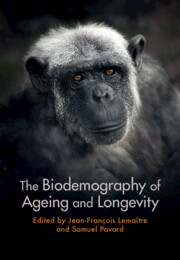Book contents
- The Biodemography of Ageing and Longevity
- The Biodemography of Ageing and Longevity
- Copyright page
- Dedication
- Contents
- Contributors
- Foreword
- Acknowledgements
- 1 The Eternal Youth of Ageing Research
- 2 Theories of Ageing across Ages
- 3 The Diversity of Longevity Metrics
- 4 The Meaning of ‘Exceptional Longevity’
- 5 The Inevitability of Senescence
- 6 The Untapped Potential of Zoo and Aquarium Data for the Comparative Biology of Ageing
- 7 Perspectives in Comparative Biology of Ageing
- 8 An Integrative Approach to Understanding Variation in the Form, Pattern and Pace of Ageing
- 9 Sex Differences in Lifespan, Ageing and Health in the Living World
- 10 Evolution of Human Reproduction, Ageing and Longevity
- 11 Lifespan and Mortality in Hunter-Gatherer and Other Subsistence Populations
- 12 Longevity in Modern Populations
- 13 Health Transition and Population Ageing
- 14 Limit of Human Longevity
- 15 Mortality Modelling at the Oldest Ages in Human Populations
- 16 Lessons from Exceptionally Long-Lived Individuals and Long-Living Families
- 17 Human Populations with Extreme Longevities
- 18 Socio-Economic Consequences of Increased Longevity in Contemporary Populations
- Index
- References
8 - An Integrative Approach to Understanding Variation in the Form, Pattern and Pace of Ageing
Published online by Cambridge University Press: 14 November 2024
- The Biodemography of Ageing and Longevity
- The Biodemography of Ageing and Longevity
- Copyright page
- Dedication
- Contents
- Contributors
- Foreword
- Acknowledgements
- 1 The Eternal Youth of Ageing Research
- 2 Theories of Ageing across Ages
- 3 The Diversity of Longevity Metrics
- 4 The Meaning of ‘Exceptional Longevity’
- 5 The Inevitability of Senescence
- 6 The Untapped Potential of Zoo and Aquarium Data for the Comparative Biology of Ageing
- 7 Perspectives in Comparative Biology of Ageing
- 8 An Integrative Approach to Understanding Variation in the Form, Pattern and Pace of Ageing
- 9 Sex Differences in Lifespan, Ageing and Health in the Living World
- 10 Evolution of Human Reproduction, Ageing and Longevity
- 11 Lifespan and Mortality in Hunter-Gatherer and Other Subsistence Populations
- 12 Longevity in Modern Populations
- 13 Health Transition and Population Ageing
- 14 Limit of Human Longevity
- 15 Mortality Modelling at the Oldest Ages in Human Populations
- 16 Lessons from Exceptionally Long-Lived Individuals and Long-Living Families
- 17 Human Populations with Extreme Longevities
- 18 Socio-Economic Consequences of Increased Longevity in Contemporary Populations
- Index
- References
Summary
Variation in the form, pattern and pace of ageing is studied by scientists in multiple disciplines and there is much to be gained from more cross-disciplinary communication. This chapter suggests here that the framework provided by Tinbergen’s ‘Four Questions’ is useful in integrating ageing research. It emphasizes the need to separate biological and chronological age and describe several markers of age-related deterioration that could be used more widely to measure biological age, with a focus on those that can be deployed outside of the standard laboratory setting and be used repeatedly in individuals to enable longitudinal studies. Whole organism frailty measures are currently little used by evolutionary ecologists and this chapter describes how these could be used more extensively. Telomere attrition and mitochondrial function are highly conserved processes and have been studied in an increasingly wide range of taxa in recent years. The chapter also discusses other markers, including those related to immune function, oxidative damage, inflammation and DNA methylation. Great progress is currently being made in the use of epigenetic alterations to provide information on chronological and biological age in a range of (predominantly) vertebrate taxa. The chapter outlines how this integrative approach could be developed further and highlight future directions.
- Type
- Chapter
- Information
- The Biodemography of Ageing and Longevity , pp. 138 - 161Publisher: Cambridge University PressPrint publication year: 2024

